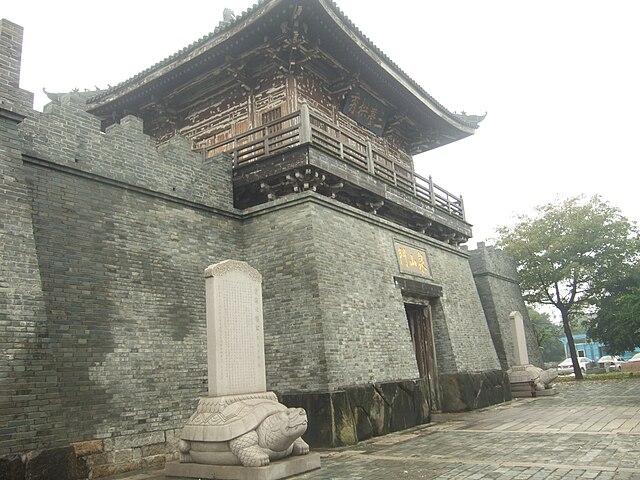
The Anping Bridge - one of the famous ancient bridges of Fujian, built from giant stone blocks, over which Galeote Pereira and his fellow detainees were carried to Fuzhou 450 years ago - has been restored, even though the sea estuary it used to cross is now mostly dry land. (沧桑!。。。)
Orchid Press seems to be in the business of reprinting older Western books about Asia, and they seem to be able to find titles that are worthy of reprinting. Although I have not seen this reprint of theirs, I have read the original edition, "South China in the Sixteenth Century (1550-1575): Being the Narratives of Galeote Pereira, Fr Gaspar Da Cruz, Op , Fr Martin De Rada, Oesa, (1550-1575) (Hakluyt Society Second Series, 1953)", and can congratulate the publisher on making this valuable book more easily available to modern readers.
Many books on the intellectual exchange between China and Europe, such as D.E. Mungello's excellent treatise on Jesuits in China, seem to begin the discussion with Matteo Ricci, viewing everything that happened earlier as a "pre-history" of sorts. In a sense, this is justified, as it were Ricci and his colleagues who made a true "exchange" a reality, as they were the first Europeans capable to directly communicate on a serious level with the Chinese intellectual elites.
However, the "pre-history" - the 70 years of failed, or only partially successful, attempts of establishing a line of communication between the two cultures (counting from the first arrival of the Portuguese to the China coast ca. 1513 and to Ricci and Ruggieri's moving from Macao to Zhaoqing to live there full-time in 1583) are also of great interest for historians. As Donald Lach notes, the first decades of these contacts were marked by almost total blackout imposed by the Portuguese on the publication of the information collected by them in East Asia. For the earliest reports of the Sino-Portuguese interactions, one should see Ferguson's "Letters from Portuguese captives in Canton, written in 1534 & 1536" (1902), which is out of print, but whose full text is available on Google Books. Chronologically, that is followed by the accounts of the contemporary Portuguese historians, João de Barros and Fernão Lopes de Castnheda. After that, it is the turn of the sources translated and annotated by C.R. Boxer in the book under review.
In this book, first published in 1953, C.R. Boxer's did a great job of presenting the 3 most important first-hand accounts of Europeans' visits to China in the 1550s-1570s.

The original stone city of Quanzhou that so much impressed early European visitors has been mostly lost, but Quanshan Gate has been restored, and even got a couple turtles to guard it!
Galeote Pereira was, essentially, a Portuguese smuggler, detained for customs and immigration violations, as well as resisting arrest, in 1549. He spent a year in a Fuzhou prison, waiting for his death, and then - after a review of his and his compatriots' case by an inspector from Beijing - several more years in exile in Guangxi. After escaping, he wrote a rather desultory, but still fascinating, account of his experiences, later published by the Jesuits.
Gaspar da Cruz was a Dominican friar, who had widely traveled throughout the Portuguese colonial empire in Asia, and - after failing to convert any Cambodians to Catholicism - tried his hand, apparently, without much more success, in Guangzhou. Back in Portugal, he published (in 1569/1570) a small book that is considered the very first European book specifically about China. (As opposed to a chapter or two about China in Marco Polo or in Barros).
Martín de Rada was a Spanish Augustinian, who led a Spanish delegation to Fujian in 1575, with a view of setting up a permanent missionary system in China, and maybe even getting a small offshore island near Amoy (Xiamen) for the Spaniards' use, similar to the Macao had by the Portuguese. (Isn't it interesting how the "spiritual" and imperialist motives coexisted in so many early missionary stories?) The mission failed, for reasons not related to de Rada's own performance, but de Rada bought a lot of Chinese books in Fujian, and after coming back wrote extensively about the country, based both on his 4 months' experience there and the information translated to him from these books by the Chinese merchants ("Sangleys") living in the Philippines.
Later on, Pereira's, Cruz's and Rada's writings all became the basis for The History of the Great and Mighty Kingdom of China and the Situation Thereof, published by Mendoza in 1585 - which was to remain a European bestseller for the next 30 years, but became virtually forgotten after being superseded by Ricci's book (1615) and other Jesuits' works.
Nonetheless, the writings of the two Portuguese and one Spaniard collected and translated by C.R. Boxer, and provided by him with an erudite preface and notes, are certainly worth reading. Maybe not so much for what they tell about the Ming China - there are, after all, lots of great modern books on the topic - but for what they tell us about the Iberians' early attempts to understand the country around them. They have made some correct observations, and also have said some things that are laughable ... but, all of it put together, this was, in a sense, a foundation on which the first generation of European scholars of China (i.e., mostly Jesuits starting with Ruggieri and Ricci) were to build.
P.S. There is apparently a more recent, 2010 reprint. For some reason Amazon pages for different editions don't automatically link to each other (as they usually would), so I am putting in this link as a service to the community.
No comments:
Post a Comment